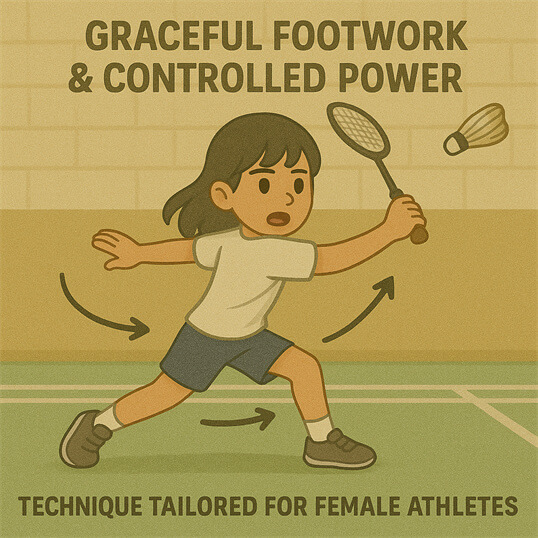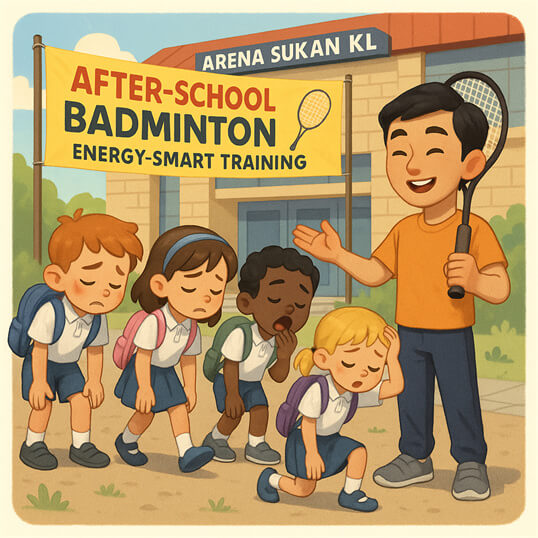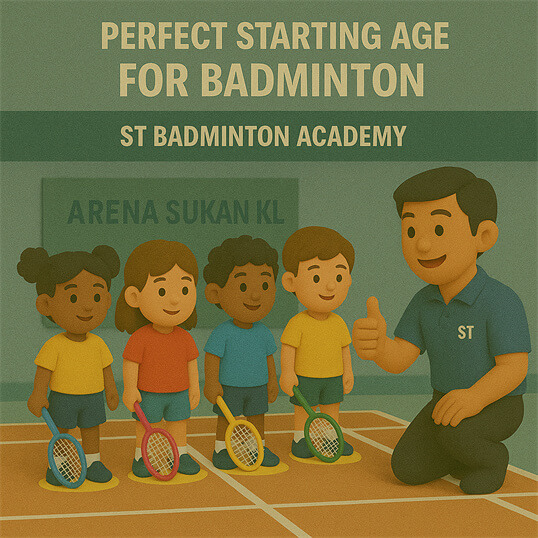Welcome to ST Badminton Academy’s badminton training in Malaysia! If you’re looking to improve your reaction time during training, then I’m here to help. It’s a crucial skill in the game of badminton and can take some serious practice if you want to excel at it. The good news is that I’ve got plenty of tips for how you can hone this essential ability so read on and get ready to become a better player!
Visualization Techniques
Improving reaction time in badminton training is essential for an athlete to stay competitive. One of the best ways to do this is through visualization techniques, which help to focus and coordinate your movements during a match.
These can include coordination drills such as catching a shuttlecock while changing direction quickly or practicing muscle memory with specific foot patterns. By visualizing each movement you make on the court, you’re able to better anticipate your opponent’s next move and react accordingly.
To further hone their reflexes, athletes should also incorporate quick feet exercises into their practice sessions. Such exercises range from simple warm-ups like hopping over lines drawn on the court to more complex activities that involve dodging obstacles at high speeds.
Doing these regularly will not only improve agility but also increase overall confidence in one’s reactions on the court.
It’s important to remember that reaction times don’t happen overnight – regular practice and dedication are key components required for success. With consistent effort and dedication towards improving both physical and mental skills, any player can be well on their way to mastering their game!
Moving forward then, let’s look at how quick feet exercises can help enhance reaction speed in badminton training.
Quick Feet Exercises
In the previous section, we discussed visualization techniques that can help you in your badminton training. Now let’s take a look at some quick feet exercises to further improve your reaction time! To jumpstart your journey towards quicker reflexes, here are four key components of any good speed drill:
| Speed Drill Component | Description |
|---|---|
| High Knees | Lift your knees high when running; this helps activate the muscles used for sprinting and jumping. |
| Quickness Drills | Perform short bursts of quick movements such as lateral shuffles or carioca steps to practice rapid coordination skills. |
| Agility Ladders | Work on agility through various ladder drills to develop footwork and balance while responding quickly to changes in direction. |
| Plyometrics | Develop explosive power with plyometric exercises like box jumps and squat jumps which require an immediate response from our body’s muscles. |
By combining all these elements into one comprehensive workout routine, you will be able to improve not only your overall speed but also the coordination of different muscle groups involved in reacting faster during a game of badminton.
Remember too that repetition is key; keep practicing consistently until it becomes second nature! With consistent effort and dedication, there’s no doubt that you’ll notice improvements in your reaction time soon enough. Time now for us to move onto anticipation drills – another important factor when it comes to mastering the sport of badminton!
Anticipation Drills
Anticipation drills are a key part of badminton training, as they help develop the skill of quickly reacting to an opponent’s shot. I often recommend incorporating anticipation drills into my clients’ practice sessions in order to improve their reaction times.
One drill that is especially effective involves having one player stand at the net and another player on the opposite side of the court. The goal is for the person standing at the net to predict where their partner will hit the shuttlecock and then move quickly to intercept it. This exercise helps teach players how to anticipate their opponent’s shots while also improving agility and speed.
In addition, reaction drills can be used to sharpen reflexes. For instance, a popular drill among badminton pros requires two players facing each other across the net with both holding a racket in one hand and a shuttlecock in the other. Other than choosing a good racket and also remember to choose the best racket restring in Malaysia.
When signaled by a coach or instructor, each player must drop his/her shuttlecock onto his/her own side of the court and attempt to hit it back over before it touches down again. This type of drill forces players out of their comfort zone as they have no time between when they let go of their shuttles until they swing their rackets – making them think fast under pressure!
To take your game even further, don’t forget about strengthening your core muscles; this plays an important role in giving you more power behind your shots as well as helping you maintain balance during rallies. Strengthening these muscles will make sure you’re always able to react quickly and effectively against any incoming shots from your opponents.
Strengthening Your Core
When it comes to improving your reaction time in badminton training, strengthening your core is a key factor. To illustrate the importance of this concept, consider the analogy of an old-fashioned spring that needs to be wound up for maximum energy efficiency; similarly, you must prime and strengthen your core muscles for better performance and improved reaction speed.
This not only includes working on muscular strength but also building up endurance so you can maintain peak physical condition during long matches or extended practice sessions.
A great way to get started with increasing your core power is by performing exercises such as planks, crunches, Russian twists, side bends and reverse curls — all of which target those important abdominal and back muscles.
You should focus on proper form throughout these movements; take care not to sacrifice technique for additional reps or weight. Additionally, if you’re just starting out then begin gradually: try lighter weights and fewer sets until you become comfortable with each exercise before progressing onto more advanced techniques.
The last step in priming your body for optimum badminton performance? Relaxation techniques that will help ensure optimal muscle recovery after intense bouts of activity – allowing you to stay focused and energized while pushing yourself further than ever before!
Relaxation Techniques
Having a strong core is essential for improving your reaction time in badminton training. But, just as important is taking the time to mentally relax and center yourself before each session. This will help you achieve mental clarity and greater focus during matches or practice sessions.
Relaxation techniques are an invaluable tool when it comes to enhancing your response time in badminton by calming both body and mind. One effective method is progressive muscle relaxation, which involves tensing and then releasing different muscles throughout the body one at a time.
You can also try breathing exercises such as diaphragmatic breathing that involve slow inhalations and exhalations with a long pause between them. Additionally, focusing on proper body alignment while performing these mindfulness practices helps improve balance and agility, allowing you to move more quickly during play.
With regular practice of these strategies, players can learn how to find their calm amidst any match’s chaos—and ultimately take their badminton game up a notch! Now we’ll look into additional ways we can sharpen our reflexes through plyometric training.
Plyometric Training
I’m a big fan of plyometric training for badminton players, as it helps to develop their speed and explosive strength. Working on drills that focus on quick movements will help to improve reaction time, and help athletes stay agile and light on their feet.
Regularly incorporating plyometric exercises into your badminton training will help to improve your reaction time and make you a better player. If you’re looking to take your badminton game to the next level, plyometric training should definitely be part of your training regimen!
Speed Development
Hey badminton players! Looking to improve your reaction time? Well, you’ve come to the right place. Plyometric training is a great way to develop speed and agility while helping you become more efficient on the court.
When it comes to plyometrics for badminton skill development, focus on drills that target reflexes as well as explosive movements. Jump squats, box jumps, or single-leg hops are all great exercises for improving power and explosiveness during play. These exercises will help build coordination between muscle groups and increase overall body strength – both of which lead to better performance on the court.
By implementing plyometrics into your regular routine, you can significantly enhance your skills and reaction time in no time! So if you want to get an edge over your opponents, start incorporating some plyo training today!
Explosive Strength
Now that you know the importance of plyometrics and how it can improve your reaction time, let’s talk about explosive strength. When it comes to badminton, having a powerful stroke is key to winning points. To help develop this type of power, short sprints, and speed drills are essential exercises for building up explosiveness on the court. These will increase muscle coordination as well as overall body strength — both of which result in more power when playing.
Try incorporating some dynamic moves such as lateral shuffles or carioca runs into your regular routine. This not only helps with agility but also works for multiple muscle groups at once — allowing for greater performance during games. It’s important to challenge yourself by pushing past your comfort zone; increasing resistance levels over time so that you continually build up more force behind each stroke!
To really get an edge over opponents, start working on explosive strength today using these simple yet effective drills!
Analyzing Your Opponent’s Movements
Analyzing your opponent’s movements is a key skill to understanding and improving your reaction time in badminton training. To do this, you must pay attention to the following three aspects:
| Strategy | Description |
|---|---|
| Tracking patterns | Keeping track of an opponent’s habits can help you anticipate their next move. By recognizing trends in their playstyle, you will be able to respond quickly and accurately when they make their next shot. |
| Body language | A skilled player can tell what kind of shot an opponent might attempt by reading their body language just before they take a swing. Paying close attention to posture, grip, stance, and footwork can give you valuable information about where the shuttlecock may go before it has even left the racquet. |
| Mind games | Playing mind games with your opponent can throw them off balance long enough for you to gain an advantage during rallies. This could involve changing up your shots regularly or even making unexpected decisions during points that surprise them each time. Being unpredictable on the court keeps opponents guessing and increases your chances of winning the point quicker than usual. |
By incorporating these techniques into your game, you will sharpen your decision-making process and hone your reflexes for faster response times between volleys and smashes. With practice comes greater precision, which translates into improved performance on the court – all essential elements for success at any level of badminton training!
Incorporating Technology
I’m a badminton training expert, and I know how difficult it can be to improve your reaction time. But with the help of technology, you can get yourself to the next level in no time! Virtual coaching is one way you can use technology for improving your reaction time. Having a coach observe you from afar gives them an opportunity to see where there’s room for improvement. They can then give you real-time feedback on what needs work, or even provide drills that are specifically designed to increase your speed.
Another great tool is motion sensors. These devices measure the velocity and acceleration of each shot so that you have tangible data to look over after practice sessions. With this information at hand, you’ll be able to track progress more easily as well as identify any areas of weakness which need more focus during future practices. Plus, if used correctly, they can also teach proper form and technique.
All in all, incorporating technology into your training routines will undoubtedly result in improved reaction times on the court – not just because of better analysis but primarily due to increased motivation and accountability too! And by taking advantage of these technologies available today, anyone looking to become faster and more precise when playing badminton should definitely consider giving them a try.
Frequently Asked Questions

How Often Should I Practice Badminton To Improve My Reaction Time?
Practicing badminton regularly is key to improving your reaction time. To maximize the benefits, focus on both mental training and physical conditioning. Mental exercises such as visualizing game scenarios can help hone reflexes and prepare you for real-time situations.
Meanwhile, regular physical drills like footwork technique practice should target speed and agility. As a training expert, I highly recommend dedicating at least 2-3 days per week to badminton practice in order to see tangible improvements in your reaction time over time.
What Specific Drills Should I Do To Improve My Reaction Time?
If you’re looking to improve your reaction time for badminton, there are a few drills that can help. Quick feet drills and coordination drills will be particularly useful. These involve activities such as stepping over cones or jumping from one side of the court to the other quickly and accurately.
You can even find various online tutorials on these types of conditioning exercises. Doing them regularly should give you the speed and agility needed to react quicker in matches!
Are There Any Helpful Apps For Improving My Reaction Time?
Are you looking for a way to improve your reaction time in badminton training? Forget about apps, I’m the only app you need! Seriously though, if you’re serious about improving your reaction time then there are some great eye tracking and footwork drills that can help you get where you want to be.
From my experience as a badminton training expert, these exercises will really help sharpen up your reflexes and give you an edge on the court.
How Long Does It Take To See Improvements In My Reaction Time?
Improving your reaction time can be a tricky process, as it involves both physical and mental factors. The amount of time it takes to see an improvement in reaction time will depend on the individual’s physiological abilities and level of mental focus.
Generally speaking, you should start seeing improvements after dedicating yourself to regular badminton training for a few weeks or months.
With consistent practice, you’ll likely experience an increase in speed that comes from a better understanding of court movement and improved muscle memory. Additionally, incorporating drills into your routine that specifically target alertness and reflexes can help improve your overall reaction time even more quickly.
Can Improving My Reaction Time Help Me Become A Better Badminton Player?
Yes, improving your reaction time can dramatically help you become a better badminton player. Faster footwork and mental focus are key components in order to improve your overall performance. When training for badminton, focus on drills that require quick reactions such as shadowing or high-intensity shuttlecock drills.
These will all contribute to increasing your speed, reflexes, and decision-making abilities which will give you an edge against the competition! In addition, take some time after each practice session to analyze what went well and what could be improved upon; this way you can see tangible progress over time.
Improve Reaction Time in Badminton Training Malaysia
With regular practice and dedication, you can drastically improve your reaction time in badminton training. Whether it’s through drills, apps or simply learning the basics of the game, you can achieve better results if you focus on mastering each element step by step. With consistent effort and patience, you will begin to notice that your reactions are becoming faster and more accurate with every passing day.
As a result, not only will your overall playing performance be enhanced but also your confidence in yourself as a player too. So don’t wait any longer, set aside some time for badminton practice each week and start perfecting those reflexes! You won’t regret it when you see how quickly your skills progress – so get out there and prove just how fast you can move!





